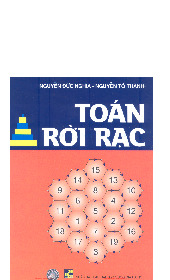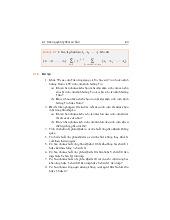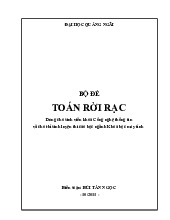



















Preview text:
Đồ thị Hamilton Trần Vĩnh Đức Ngày 11 tháng 3 năm 2016 1 / 24 Tài liệu tham khảo
▶ Ngô Đắc Tân, Lý thuyết Tổ hợp và Đồ thị, NXB ĐHQG Hà Nội, 2004.
▶ Douglas B. West. Introduction to Graph Theory. 2nd Edition, 2000.
▶ K. Rosen, Toán học rời rạc ứng dụng trong tin học (Bản dịch Tiếng Việt) 2 / 24 Đi vòng quanh thế giới 10.5 Euler and Hamilton Paths 699 (a) (b) FIGURE 9 A Solution to FIGURE 8
Hamilton’s “A Voyage Round the
the “A Voyage Round the World” Puzzle. World” Puzzle.
Because the author cannot supply each reader with a wooden solid with pegs and string, we
will consider the equivalent question: Is there a circuit in the graph shown in Figure 8(b) that
passes through each vertex exactly once? This solves the puzzle because
3 / 24 this graph is isomorphic
to the graph consisting of the vertices and edges of the dodecahedron. A solution of Hamilton’s puzzle is shown in Figure 9.
EXAMPLE 5 Which of the simple graphs in Figure 10 have a Hamilton circuit or, if not, a Hamilton path?
Solution: G1 has a Hamilton circuit: a, b, c, d, e, a. There is no Hamilton circuit in G2 (this can
be seen by noting that any circuit containing every vertex must contain the edge {a, b} twice),
but G2 does have a Hamilton path, namely, a, b, c, d. G3 has neither a Hamilton circuit nor a
Hamilton path, because any path containing all vertices must contain one of the edges {a, b},
{e, f }, and {c, d} more than once. ▲ a b a b a b g e c d c d c e f G1 G2 G3 d
FIGURE 10 Three Simple Graphs.
CONDITIONS FOR THE EXISTENCE OF HAMILTON CIRCUITS Is there a simple way
to determine whether a graph has a Hamilton circuit or path? At first, it might seem that there
should be an easy way to determine this, because there is a simple way to answer the similar
question of whether a graph has an Euler circuit. Surprisingly, there are no known simple
necessary and sufficient criteria for the existence of Hamilton circuits. However, many theorems
are known that give sufficient conditions for the existence of Hamilton circuits. Also, certain
properties can be used to show that a graph has no Hamilton circuit. For instance, a graph with a
vertex of degree one cannot have a Hamilton circuit, because in a Hamilton circuit, each vertex
is incident with two edges in the circuit. Moreover, if a vertex in the graph has degree two, then
both edges that are incident with this vertex must be part of any Hamilton circuit. Also, note
that when a Hamilton circuit is being constructed and this circuit has passed through a vertex,
then all remaining edges incident with this vertex, other than the two used in the circuit, can be
removed from consideration. Furthermore, a Hamilton circuit cannot contain a smaller circuit within it. Con Mã đi trên bàn cờ 4 / 24 Con Mã đi trên bàn cờ 2 5 / 24
Định nghĩa (Đồ thị nửa Hamilton)
▶ Một đường đi trong đồ thị G được gọi là đường đi Hamilton
nếu nó chứa tất cả các đỉnh của G.
▶ Một đồ thị được gọi là đồ thị nửa Hamilton nếu nó có đường đi Hamilton.
Nói cách khác, đồ thị nửa Hamilton là đồ thị có đường đi bao trùm. 6 / 24 10.5 Euler and Hamilton Paths 699 (a) (b) FIGURE 9 A Solution to FIGURE 8
Hamilton’s “A Voyage Round the
the “A Voyage Round the World” Puzzle. World” Puzzle.
Because the author cannot supply each reader with a wooden solid with pegs and string, we
will consider the equivalent question: Is there a circuit in the graph shown in Figure 8(b) that
passes through each vertex exactly once? This solves the puzzle because this graph is isomorphic
to the graph consisting of the vertices and edges of the dodecahedron. A solution of Hamilton’s puzzle is shown in Figure 9.
EXAMPLE 5 Which of the simple graphs in Figure 10 have a Hamilton circuit or, if not, a Hamilton path?
Solution: G1 has a Hamilton circuit: a, b, c, d, e, a. There is no Hamilton circuit in G2 (this can
be seen by noting that any circuit containing every vertex must contain the edge {a, b} twice),
but G2 does have a Hamilton path, namely, a, b, c, d. G3 has neither a Hamilton circuit nor a Ví dụ
Hamilton path, because any path containing all vertices must contain one of the edges {a, b},
{e, f }, and {c, d} more than once. ▲
Đồ thị nào dưới đây là nửa Hamilton? a b a b a b g e c d c d c e f G1 G2 G3 d
FIGURE 10 Three Simple Graphs.
CONDITIONS FOR THE EXISTENCE OF HAMILTON CIRCUITS Is there a simple way
to determine whether a graph has a Hamilton circuit or path? At first, it might seem that there
should be an easy way to determine this, because there is a simple way to answer the similar
question of whether a graph has an Euler circuit. Surprisingly, there are no known simple 7 / 24
necessary and sufficient criteria for the existence of Hamilton circuits. However, many theorems
are known that give sufficient conditions for the existence of Hamilton circuits. Also, certain
properties can be used to show that a graph has no Hamilton circuit. For instance, a graph with a
vertex of degree one cannot have a Hamilton circuit, because in a Hamilton circuit, each vertex
is incident with two edges in the circuit. Moreover, if a vertex in the graph has degree two, then
both edges that are incident with this vertex must be part of any Hamilton circuit. Also, note
that when a Hamilton circuit is being constructed and this circuit has passed through a vertex,
then all remaining edges incident with this vertex, other than the two used in the circuit, can be
removed from consideration. Furthermore, a Hamilton circuit cannot contain a smaller circuit within it.
Định nghĩa (Đồ thị Hamilton)
▶ Một chu trình trong đồ thị G được gọi là chu trình Hamilton
nếu nó chứa tất cả các đỉnh của G.
▶ Một đồ thị được gọi là đồ thị Hamilton nếu nó có chu trình Hamilton.
Nói cách khác, đồ thị Hamilton là đồ thị có chu trình bao trùm. 8 / 24 10.5 Euler and Hamilton Paths 699 (a) (b) FIGURE 9 A Solution to FIGURE 8
Hamilton’s “A Voyage Round the
the “A Voyage Round the World” Puzzle. World” Puzzle.
Because the author cannot supply each reader with a wooden solid with pegs and string, we
will consider the equivalent question: Is there a circuit in the graph shown in Figure 8(b) that
passes through each vertex exactly once? This solves the puzzle because this graph is isomorphic
to the graph consisting of the vertices and edges of the dodecahedron. A solution of Hamilton’s puzzle is shown in Figure 9.
EXAMPLE 5 Which of the simple graphs in Figure 10 have a Hamilton circuit or, if not, a Hamilton path?
Solution: G1 has a Hamilton circuit: a, b, c, d, e, a. There is no Hamilton circuit in G2 (this can
be seen by noting that any circuit containing every vertex must contain the edge {a, b} twice),
but G2 does have a Hamilton path, namely, a, b, c, d. G3 has neither a Hamilton circuit nor a Ví dụ
Hamilton path, because any path containing all vertices must contain one of the edges {a, b},
{e, f }, and {c, d} more than once. ▲
Đồ thị nào dưới đây là Hamilton? a b a b a b g e c d c d c e f G1 G2 G3 d
FIGURE 10 Three Simple Graphs.
CONDITIONS FOR THE EXISTENCE OF HAMILTON CIRCUITS Is there a simple way
to determine whether a graph has a Hamilton circuit or path? At first, it might seem that there
should be an easy way to determine this, because there is a simple way to answer the similar
question of whether a graph has an Euler circuit. Surprisingly, there are no known simple 9 / 24
necessary and sufficient criteria for the existence of Hamilton circuits. However, many theorems
are known that give sufficient conditions for the existence of Hamilton circuits. Also, certain
properties can be used to show that a graph has no Hamilton circuit. For instance, a graph with a
vertex of degree one cannot have a Hamilton circuit, because in a Hamilton circuit, each vertex
is incident with two edges in the circuit. Moreover, if a vertex in the graph has degree two, then
both edges that are incident with this vertex must be part of any Hamilton circuit. Also, note
that when a Hamilton circuit is being constructed and this circuit has passed through a vertex,
then all remaining edges incident with this vertex, other than the two used in the circuit, can be
removed from consideration. Furthermore, a Hamilton circuit cannot contain a smaller circuit within it. 700 10 / Graphs Ví dụ
Đồ thị nào dưới là Hamilton? Nếu không, có là nửa Hamilton? a d e a d c b c b e G H
FIGURE 11 Two Graphs That Do Not Have a Hamilton Circuit.
EXAMPLE 6 Show that neither graph displayed in Figure 11 has a Hamilton circuit. 10 / 24
Solution: There is no Hamilton circuit in G because G has a vertex of degree one, namely, e.
Now consider H . Because the degrees of the vertices a, b, d, and e are all two, every edge
incident with these vertices must be part of any Hamilton circuit. It is now easy to see that no
Hamilton circuit can exist in H , for any Hamilton circuit would have to contain four edges
incident with c, which is impossible. ▲
EXAMPLE 7 Show that Kn has a Hamilton circuit whenever n ≥ 3.
Solution: We can form a Hamilton circuit in Kn beginning at any vertex. Such a circuit can be
built by visiting vertices in any order we choose, as long as the path begins and ends at the same
vertex and visits each other vertex exactly once. This is possible because there are edges in Kn between any two vertices. ▲
Although no useful necessary and sufficient conditions for the existence of Hamilton circuits
are known, quite a few sufficient conditions have been found. Note that the more edges a graph
has, the more likely it is to have a Hamilton circuit. Furthermore, adding edges (but not vertices)
to a graph with a Hamilton circuit produces a graph with the same Hamilton circuit. So as we
add edges to a graph, especially when we make sure to add edges to each vertex, we make it
WILLIAM ROWAN HAMILTON (1805–1865)
William Rowan Hamilton, the most famous Irish scien-
tist ever to have lived, was born in 1805 in Dublin. His father was a successful lawyer, his mother came
from a family noted for their intelligence, and he was a child prodigy. By the age of 3 he was an excel-
lent reader and had mastered advanced arithmetic. Because of his brilliance, he was sent off to live with
his uncle James, a noted linguist. By age 8 Hamilton had learned Latin, Greek, and Hebrew; by 10 he had
also learned Italian and French and he began his study of oriental languages, including Arabic, Sanskrit, and
Persian. During this period he took pride in knowing as many languages as his age. At 17, no longer de-
voted to learning new languages and having mastered calculus and much mathematical astronomy, he began
original work in optics, and he also found an important mistake in Laplace’s work on celestial mechanics.
Before entering Trinity College, Dublin, at 18, Hamilton had not attended school; rather, he received private tutoring. At Trinity, he
was a superior student in both the sciences and the classics. Prior to receiving his degree, because of his brilliance he was appointed
the Astronomer Royal of Ireland, beating out several famous astronomers for the post. He held this position until his death, living
and working at Dunsink Observatory outside of Dublin. Hamilton made important contributions to optics, abstract algebra, and
dynamics. Hamilton invented algebraic objects called quaternions as an example of a noncommutative system. He discovered the
appropriate way to multiply quaternions while walking along a canal in Dublin. In his excitement, he carved the formula in the stone
of a bridge crossing the canal, a spot marked today by a plaque. Later, Hamilton remained obsessed with quaternions, working to
apply them to other areas of mathematics, instead of moving to new areas of research.
In 1857 Hamilton invented “The Icosian Game” based on his work in noncommutative algebra. He sold the idea for 25 pounds
to a dealer in games and puzzles. (Because the game never sold well, this turned out to be a bad investment for the dealer.) The
“Traveler’s Dodecahedron,” also called “A Voyage Round the World,” the puzzle described in this section, is a variant of that game.
Hamilton married his third love in 1833, but his marriage worked out poorly, because his wife, a semi-invalid, was unable to
cope with his household affairs. He suffered from alcoholism and lived reclusively for the last two decades of his life. He died from
gout in 1865, leaving masses of papers containing unpublished research. Mixed in with these papers were a large number of dinner
plates, many containing the remains of desiccated, uneaten chops. Ví dụ
Chứng minh rằng đồ thị đầy đủ Kn có chu trình Hamilton với mọi n ≥ 3. 11 / 24 Mệnh đề
Nếu G = (V, E) có chu trình Hamilton, vậy thì với mọi tập đỉnh
khác rỗng S ⊆ V, đồ thị thu được từ G bằng cách xóa các đỉnh
thuộc S chỉ có nhiều nhất |S| thành phần liên thông. Chứng minh. 12 / 24 Ví dụ
Đồ thị sau có phải là Hamilton không? 13 / 24 Ví dụ
Đồ thị sau đây chỉ ra rằng điều kiện cần trước không phải điều kiện đủ. Tại sao? 14 / 24 Bài tập
Alice và Bob nhìn trộm đề thi Toán Rời Rạc của thầy Đức. Alice
thấy thầy đang mô tả một đồ thị với 17 đỉnh và 129 cạnh; còn
Bob thấy thầy hỏi xem đồ thị này có chu trình Hamilton không.
- Bob nói rằng: ”không cần biết chi tiết đồ thị thầy đang vẽ thế
nào, chắc chắn đồ thị này có chu trình Hamilton.”
- Còn Alice nói: ”Nếu không biết chi tiết thì không thể quyết định
được đồ thị này có chu trình Hamilton hay không.”
Ai đúng, ai sai? Bạn hãy giải thích. 15 / 24 Định lý (Ore)
Giả sử G là một đơn đồ thị với n ≥ 3 đỉnh thỏa mãn: với mọi cặp
đỉnh không liền kề u và v, ta có
deg(u) + deg(v) ≥ n,
khi đó G là đồ thị Hamilton. 16 / 24 Chứng minh định lý Ore
▶ Giả sử định lý không đúng.
▶ Tồn tại đồ thị G = (V, E) với n đỉnh và có nhiều cạnh nhất
thỏa mãn điều kiện của định lý Ore nhưng không là Hamilton. Tại sao?
▶ Vì G có nhiều cạnh nhất có thể nên đồ thị thu được bằng
cách thêm một cạnh mới nối hai đỉnh không kề nhau phải có
chu trình Hamilton chứa cạnh thêm đó. Tại sao?
▶ Vậy giữa hai đỉnh bất kỳ trong G có thể nối với nhau bằng một đường Hamilton. 17 / 24 Chứng minh (tiếp)
▶ Vì đồ thị Kn có chu trình Hamilton nên G ̸= Kn.
▶ Vậy tồn tại hai đỉnh v1 và vn không kề nhau trong G,
▶ và tồn tại đường Hamilton: v v 1 v2 n−1 vn . . . 18 / 24 Chứng minh (tiếp)
▶ Giả sử v1 kề với k đỉnh là: vi , v , · · · , v và 1 i2 ik
2 = i1 < i2 < · · · < ik
▶ Đỉnh vn không thể kề với đỉnh vij−1 nào (2 ≤ j ≤ k) vì nếu
không sẽ tồn tại chu trình Hamilton: v v v 1 v2 ij−1 vij n−1 vn . . . . . . 19 / 24 Chứng minh (tiếp) v v v 1 v2 ij−1 vij n−1 vn . . . . . .
▶ Vậy vn không kề với ít nhất k đỉnh {vi1−1, vi2−1, . . . , vik−1, }. Tức là
deg(vn) ≤ n − 1 − k ▶ Nhưng vậy thì
n ≤ deg(v1) + deg(vn) ≤ k + (n − 1 − k) = n − 1 7 20 / 24




